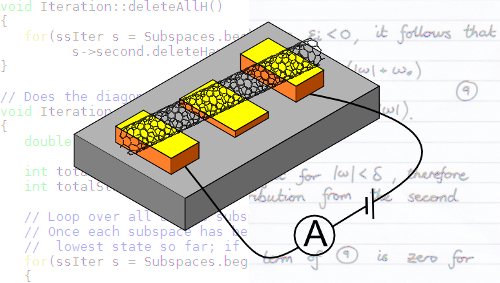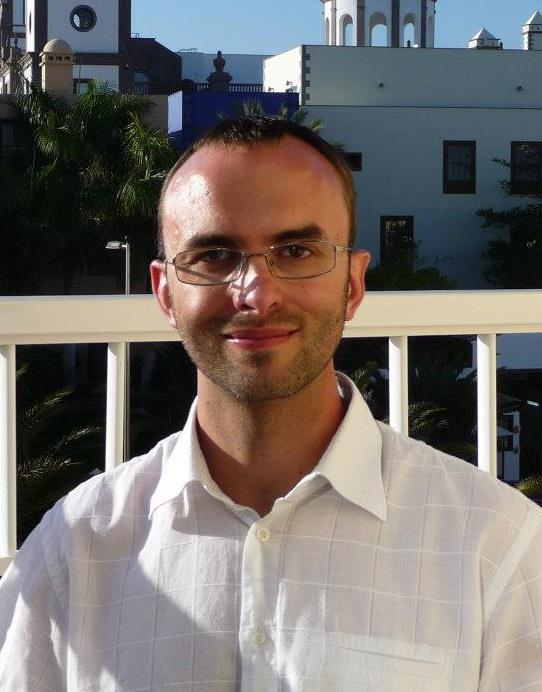Background
I am the Deputy Director of Studies in Chemistry at Oxford, and a Supernumerary Fellow of University College, Oxford.
I have longstanding interests in university teaching and learning. I teach Mathematics for Chemistry as part of the undergraduate MChem course, and I am currently developing the Chemistry Department's Graduate Training Programme, combining training in both research and transferable skills for our postgraduate research students.
I am also involved in College, Departmental and university-wide outreach schemes, helping to encourage talented students to explore Chemistry and Maths beyond their school syllabus, build self-confidence, and consider applying to Oxford.
Teaching

I lecture the first-year undergraduate Mathematics for Chemistry course, and have previously lectured graduate students within the TMCS CDT and the MSc in Theoretical and Computational Chemistry. I combine traditional 'chalk and talk'-style lecturing with computer visualisations and online video resources.
To find online teaching material for my undergraduate maths courses, please see the course websites (Oxford only).My previous graduate-level maths course, covering aspects of multivariable calculus and vector calculus, is available here
Research
 My main research interests lie in the field of condensed matter theory, where the aim is to characterise and understand the physical properties of materials consisting of enormously large numbers of interacting particles. Of particular interest to me are 'strongly-correlated' systems, where the interactions between particles cannot be treated using so-called mean-field approaches (where only the 'average' behaviour of the particles needs to be considered). For these systems, one must instead develop quantum many-body theories, in which the true, correlated motion of the particles is taken explicitly into account.
My main research interests lie in the field of condensed matter theory, where the aim is to characterise and understand the physical properties of materials consisting of enormously large numbers of interacting particles. Of particular interest to me are 'strongly-correlated' systems, where the interactions between particles cannot be treated using so-called mean-field approaches (where only the 'average' behaviour of the particles needs to be considered). For these systems, one must instead develop quantum many-body theories, in which the true, correlated motion of the particles is taken explicitly into account.
 I have previously worked on understanding many-body effects on the nanoscale, as observed in the electronic conductance of single molecules, carbon nanotubes and other 'quantum dot' devices. I have more recently been working on correlated electron behaviour in bulk materials such as heavy fermion compounds. I'm also interested in developing general theories for approximating many-body systems, and in numerical methods such as the Numerical Renormalization Group and Continuous-Time Quantum Monte Carlo. For more information, see my publication list below.
I have previously worked on understanding many-body effects on the nanoscale, as observed in the electronic conductance of single molecules, carbon nanotubes and other 'quantum dot' devices. I have more recently been working on correlated electron behaviour in bulk materials such as heavy fermion compounds. I'm also interested in developing general theories for approximating many-body systems, and in numerical methods such as the Numerical Renormalization Group and Continuous-Time Quantum Monte Carlo. For more information, see my publication list below.
I'm also interested in collaborating with other chemists in the Department, on anything that I can help with!
Publications
- Martin R. Galpin, David E. Logan and H. R. Krishnamurthy
Quantum Phase Transition in Capacitively Coupled Double Quantum Dots
Phys. Rev. Lett. 94, 186406 (2005). - Martin R. Galpin and David E. Logan
Single-particle dynamics of the Anderson model: a two-self-energy description within the numerical renormalization group approach
J. Phys.: Condens. Matter 17, 6959 (2005). - Martin R. Galpin, David E. Logan and H. R. Krishnamurthy
Renormalization group study of capacitively coupled double quantum dots
J. Phys.: Condens. Matter 18, 6545 (2006). - Martin R. Galpin, David E. Logan and H. R. Krishnamurthy
Dynamics of capacitively coupled double quantum dots
J. Phys.: Condens. Matter 18, 6571 (2006). - Andrew K. Mitchell, Martin R. Galpin and David E. Logan
Gate voltage effects in capacitively coupled double quantum dots
Europhys. Lett. 76, 95 (2006). - David E. Logan and Martin R. Galpin
Evolution and destruction of the Kondo effect in a capacitively coupled double dot system
Int. J. Mod. Phys. B 21, 2191 (2007). - Frithjof B. Anders, David E. Logan, Martin R. Galpin and Gleb Finkelstein
Zero-bias conductance in carbon nanotube quantum dots
Phys. Rev. Lett. 100, 086809 (2008) - Martin R. Galpin and David E. Logan
Anderson impurity model in a semiconductor
Phys. Rev. B 77, 195108 (2008) - Martin R. Galpin and David E. Logan
A local moment approach to the gapped Anderson model
Eur. Phys. J. B 62, 129 (2008) - David E. Logan and Martin R. Galpin
Tunneling transport and spectroscopy in carbon nanotube quantum dots
J. Chem. Phys. 130, 224503 (2009) - Martin R. Galpin, Anne B. Gilbert and David E. Logan
A local moment approach to the degenerate Anderson impurity model
J. Phys.: Condens. Matter 21, 375602 (2009) - David E. Logan, Christopher J. Wright and Martin R. Galpin
Correlated electron physics in two-level quantum dots: phase transitions, transport, and experiment
Phys. Rev. B 80, 125117 (2009) - Martin R. Galpin, Frederic W. Jayatilaka, David E. Logan and Frithjof B. Anders
Interplay between Kondo physics and spin-orbit coupling in carbon nanotube quantum dots
Phys. Rev. B 81, 075437 (2010) - Frederic W. Jayatilaka, Martin R. Galpin and David E. Logan
Two-channel Kondo physics in tunnel-coupled double quantum dots
Phys. Rev. B 84, 115111 (2011) - Christopher J. Wright, Martin R. Galpin and David E. Logan
Magnetic field effects in few-level quantum dots: Theory and application to experiment
Phys. Rev. B 84, 115308 (2011) - Simon. J. Chorley, Martin R. Galpin, Frederic W. Jayatilaka, Charles G. Smith, David E. Logan and Mark R. Buitelaar
Tunable Kondo Physics in a Carbon Nanotube Double Quantum Dot
Phys. Rev. Lett. 109, 156804 (2012) - Andrew K. Mitchell, Thomas F. Jarrold. Martin R. Galpin and David E. Logan
Local moment formation and Kondo screening in impurity trimers
J. Phys. Chem. B 117, 12777 (2013) - Martin R. Galpin, Andrew K. Mitchell, Jesada Temaismithi, David E. Logan, Benjamin Beri and Nigel R. Cooper
Conductance fingerprint of Majorana fermions in the topological Kondo effect
Phys. Rev. B. 89, 045143 (2014) - Andrew K. Mitchell, Martin R. Galpin, Samuel Wilson-Fletcher, David E. Logan and Ralf Bulla
Generalized Wilson chain for solving multichannel quantum impurity problems
Phys. Rev. B. 89, 121105(R) (2014) - David E. Logan, Adam P. Tucker and Martin R. Galpin
Common non-Fermi liquid phases in quantum impurity physics
Phys. Rev. B. 90, 075150 (2014) - David E. Logan and Martin R. Galpin
Mott insulators and the doping-induced Mott transition within DMFT: exact results for the one-band Hubbard model J. Phys.: Condens. Matter 28, 025601 (2016) - David E. Logan, Martin R. Galpin and Jonathan Mannouch
Mott transitions in the Periodic Anderson Model J. Phys.: Condens. Matter 28, 455601 (2016) (See also this JPhys+ blog post) - Georg K. A. Hochberg, Dale A. Shepherd, Erik G. Marklund, Indu Santhanagoplan, Matteo T. Degiacomi, Arthur Laganowsky, Timothy M. Allison, Eman Basha, Michael T. Marty, Martin R. Galpin, Weston B. Struwe, Andrew J. Baldwin, Elizabeth Vierling and Justin L. P. Benesch
Structural principles that enable oligomeric small heat-shock protein paralogs to evolve distinct functions
Science 359, 930 (2018) - Gavin Young, Nikolas Hundt, Daniel Cole, Adam Fineberg, Joanna Andrecka, Andrew Tyler, Anna Olerinyova, Ayla Ansari, Erik G. Marklund, Miranda P. Collier, Shane A. Chandler, Olga Tkachenko, Joel Allen, Max Crispin, Neil Billington, Yasuharu Takagi, James R. Sellers, C?dric Eichmann, Philipp Selenko, Lukas Frey, Roland Riek, Martin R. Galpin, Weston B. Struwe, Justin L. P. Benesch, Philipp Kukura
Quantitative mass imaging of single biological macromolecules
Science 360, 423 (2018)
(see also this Perspective) - Gus Hancock, Shrinivas Sharma, Martin Galpin, Daniel Lunn, Clare Megson, Rob Peverall, Graham Richmond, Grant A D Ritchie and Katharine R Owen
The correlation between breath acetone and blood betahydroxybutyrate in individuals with type 1 diabetes
J. Breath Res.15, 017101 (2021)
Contact details
My postal address is:
Martin Galpin
Physical and Theoretical Chemistry Laboratory
South Parks Road
Oxford,
OX1 3QZ.
Tel: +44 (0)1865 285721 (direct)
